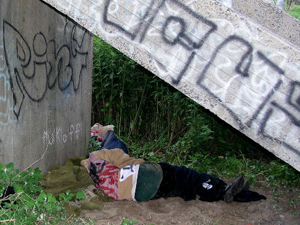Homes for Those Without a Place
 The idea of home, of a sense of place, is a vital thread in conservative thought. It’s crucial to the conservative emphasis on community, family, and local institutions. Yet amid the incessant discussions on this theme, it’s easy to forget how such a basic good as a literal home is unobtainable for so many homeless Americans. On any night in the U.S. there are roughly 400,000 to 650,000
The idea of home, of a sense of place, is a vital thread in conservative thought. It’s crucial to the conservative emphasis on community, family, and local institutions. Yet amid the incessant discussions on this theme, it’s easy to forget how such a basic good as a literal home is unobtainable for so many homeless Americans. On any night in the U.S. there are roughly 400,000 to 650,000
100,000 Homes is a remarkable grassroots campaign that has been trying to house the most at-risk homeless people throughout the U.S. for the past four years. They recently hit their goal of housing over 100,000 by July 2014. To achieve this goal, they have been working with private charities, business people, community leaders, volunteers, and governments across the nation. They have focused on coordinating the efforts of pre-existing and new organizations and implementing a grounded, systematic approach to helping the homeless.
While their goal is ambitious, the people involved in the 100,000 Homes campaign are realists. 100,000 is a large number, but they are focused solely on housing, “no strings attached.” In a fascinating 60 Minutes special (watch it here and here), one of the group’s spokespeople explained that their approach is not about fairness, but about a practical consideration of alternatives. They have specifically targeted the chronically homeless (those who are not transitioning quickly) for aid. Offering these people a permanent home is actually more cost effective for the community than allowing them to remain homeless, since their use of hospital, police, and other community services is much greater when they are living on the street.
The demographics of homelessness are tragic from the get-go. Many are suffering from significant physical or mental illness, substance abuse is prevalent, and a depressingly high number are war veterans. On top of that, homelessness has health effects similar to cancer, reducing life expectancy by decades, and these many ill effects force homeless people to become regular patrons of their local emergency rooms. 100,000 Homes makes a pretty compelling argument: Do you want to spend more by keeping people on the street or spend less and also provide them with a home?
These homes come largely without strings attached, but the tenants are required to pay 30% of any income they bring in towards their housing. These homes have the added significant benefit of assigning each homeless person a fixed location where they can be found and helped by social workers and other ministries who may otherwise have difficulty finding them.
It’s especially exciting to see how this campaign seeks to bring various groups together in a common cause. It isn’t looking purely to government or some big-name charity for aid. They have helped bring a large diversity of players together (the 60 Minutes special shows some inspiring examples of this cooperation). And this is a boots-on-the-ground effort: their main first objective when starting in a new location is to send volunteers out at 3AM to take a survey of area homeless people to determine which are chronically homeless. The volunteers talk to the homeless about their current living conditions, employment status, health, and recent history. They compile and assess this information, and those people most at risk are brought into the program first.
Thankfully, 100,000 Homes also recognizes the limitations of their work. They realize that people need more than just a home, but they also see a home as an essential starting place. Having a place where you permanently reside not only benefits you physically, it also provides you with a better connection to those around you. With a chance to shower, shave, get out of the elements, have a permanent address, and meet regularly with social workers, the homeless have a real shot at improving their health and their situation. In addition to these practical benefits, the homeless person is able to transition from often being viewed as a nuisance to instead being viewed as a neighbor. Having a home is an important first building block in helping the homeless person transition to becoming a thriving member of their community.
Of course, not all outcomes will be good, and simply providing a house will not “fix” people. The 60 Minutes special made this clear, showing us people with substance abuse problems for which housing was not a quick cure. But at the end of the day, we are left with the simple question: If housing the homeless can improve their living situation and health and, thereby, reduce taxpayer costs associated with unpaid emergency room care and other services, what step would you take?
Impressively, 100,000 Homes met their goal of placing 100,000 homeless people in homes, and all the human hands involved deserve our respect. The campaign proves how effective people can be in helping the poor when they’re coordinated: Charities, churches, businesspeople, and governments working together and guided by a systematic approach.
The poor will certainly always be among us, but this is an impressive success story in taking a big step to help a large number of the worst-off in our country. Take fifteen minutes and learn a bit about their process and success. Consider lending a hand to help the homeless in your own community. The success of 100,000 Homes is inspiring and should warm the heart of all those inclined towards helping their neighbors develop a real sense of place.

